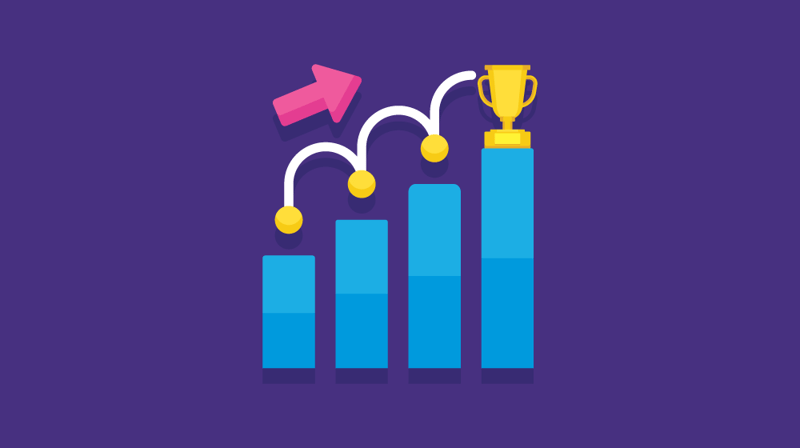Everyone involved in shaping student learning has a responsibility to do meaningful and impactful assessment.
Assessment should help you answer essential questions about the student learning experience. And because of the care you hopefully put into crafting learning outcomes for student engagement, you should be measuring reality compared to expectations.
If you’re teaching a course or facilitating a co-curricular workshop – especially in an online modality – you’ll have ample data available for assessment. Certainly, you can find summative data to inform future improvements, but this blog will focus on formative assessment methods — that is, data you can review and changes you can make while the experience is still occurring. You can learn more about formative versus summative assessments here but, for now, let’s dig into techniques for data-informed instruction.
Shaping Your Approach
As with any assessment cycle, the place to start is with outcome mapping and assessment planning. By aligning outcomes and interventions, you can narrow your focus as to what and where to assess. Outcome maps can help identify opportunities to string together complementary data sources. And multiple data sources can enable you to draw connections for performance over time and across interventions for student success.
As you determine methods and data sources, targets within assessment plans can help set the tone for what outcomes you expect. It is important to leverage multiple stakeholder perspectives in assessment planning, as it’ll paint a picture for what learning could look like and how to notice if students are off track.
Multiple perspectives matter since student learning is not always the same for each student. You should consider a variety of behaviors, strategies, and performances to inform your approach and response to observations.
Check your perspective with respect to your data, especially as time goes on within any given intervention. Be mindful of timing and student investment in your course or workshop. How might engagement look different in the first hour versus the first day or the first week? What does student learning or progress look like at an early milestone versus halfway through or near the end of the experience? It’s vital to consider this, particularly as you determine appropriate responses.
For example, if a student isn’t turning in their work, they may need an intervention to quickly uncover the root of the issue — whether it’s technical, academic, or personal. The same could be said for a student whose class attendance is strong but is turning in incomplete assignments; reach out to understand what is going on.
And for students who engage and excel initially but then their behavior becomes inconsistent over time, be sure to check in. Sudden changes in behavior can be indicative of a change in circumstances, which may necessitate resources and support from other areas of the institution.
Reflective Action
After working to understand and analyze your data, take time to review the results before taking action. Consider the following questions as you look to make the best use of assessment data:
- What do you need to focus on? What are the priorities or what pieces of information do you need to act upon soonest?
- What do you think you need to do? Identify action steps you can take. This can include setting a meeting or passing information along to another person or office. You don’t always need to have the answer immediately, especially in an evolving situation.
- What does the data really tell you? Be careful not to jump to conclusions or make hasty changes without thoroughly reviewing the data. What are you observing from the data versus inferring or interpreting to give the data meaning?
- What is within your power to change? Given your focus, action steps, and what the data is telling you, be realistic about what you can do. Be quick to refer or bring in colleagues for support whenever necessary and appropriate. Likewise, be sure to note what is beyond your control or the scope of the situation. For example, if students wish an event was held in a different venue or at a different time of year, that isn’t likely something you could change given that the activity is already underway.
- What would improvement or success look like after implementing change(s)? If you take action and intervene for students who are stalled in their progress, be sure to reassess your expectations. For students who were not engaging before, what should improvement look like after you interact with them? If students were struggling with a given concept, what should learning look like at the next milestone once they’re given additional information or you’ve intervened in another way?
Be intentional and document your ideas and actions. This documentation should not only capture your interpretation of what occurred and what you plan to do about it, but it can also create a record for reflection of future educators who may coordinate the same interventions or deal with similar student behaviors.
To that end, be sure to think about who you would engage in action planning as you share your reflection and results. Once you determine which audiences to engage, plan for when and how you’ll present information and collaborate to make improvements. You have plenty of options for interested stakeholders, including your direct coworkers, faculty and staff in other departments across the institution, students, and maybe even external audiences interested in the nature of the interventions. As you relay your data-informed work, look to maximize the engagement opportunity by appealing to each person’s unique interests.
Given the abundance of data available and the fact that students deserve the best learning environments possible, it is important you have an intentional plan to use the data available to you. Reflective practice is key for informing your perspective and interpreting results for potential improvements. And, most importantly, you should look to use and act on the data available to you so as to support and encourage student success in your ongoing experiences.
How have you utilized data to improve the courses you facilitate or workshops you lead? We’d love to hear your stories of success! Connect with us on Twitter @themoderncampus and @JoeBooksLevy





